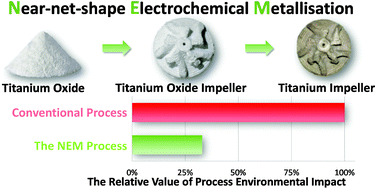当前位置:
X-MOL 学术
›
Green Chem.
›
论文详情
Our official English website, www.x-mol.net, welcomes your
feedback! (Note: you will need to create a separate account there.)
Environmental assessment of the near-net-shape electrochemical metallisation process and the Kroll-electron beam melting process for titanium manufacture
Green Chemistry ( IF 9.3 ) Pub Date : 2020/02/19 , DOI: 10.1039/c9gc04036f Aleksei Dolganov 1, 2, 3 , Matthew T. Bishop 1, 2, 2, 3, 4 , Marco Tomatis 5, 6, 7, 8, 9 , George Z. Chen 1, 2, 2, 3, 4 , Di Hu 1, 2, 2, 3, 4
Green Chemistry ( IF 9.3 ) Pub Date : 2020/02/19 , DOI: 10.1039/c9gc04036f Aleksei Dolganov 1, 2, 3 , Matthew T. Bishop 1, 2, 2, 3, 4 , Marco Tomatis 5, 6, 7, 8, 9 , George Z. Chen 1, 2, 2, 3, 4 , Di Hu 1, 2, 2, 3, 4
Affiliation

|
The enforcement of environmental policies, in recent years, has become one of the major driving forces for industrial upgrading. Therefore, this study is focused on the evaluation of the environmental impact of a newly proposed titanium additive manufacturing process, including its in-depth comparison with the conventional method. This new method, referred to as near-net-shape electrochemical metallisation, is based on the in situ metallisation (via the FFC-Cambridge process) of 3D-printed titanium oxide precursors (using direct ink writing process). In order to evaluate the main contributors to the environmental damage and to compare them with the conventional route for titanium manufacturing, the gate-to-gate life cycle assessment has been conducted following the established international standards. From this, the main contributors within the near-net-shape electrochemical metallisation process were identified to be electricity and synthetic rutile, with medium impacts from argon and nickel. It was found that major impacts were challenging to be reduced without affecting the properties of the final product. However, the medium impacts can theoretically be modified, yielding potential improvements in the sustainability of the process by 10%. When compared to the conventional route (consisting of the Kroll process, Free fall gas atomisation and electron beam melting), the end point results demonstrated that, by adopting the near-net-shape electrochemical metallisation process, the overall impact of titanium fabrication was dramatically reduced. Specifically, an average reduction of 68% for the ecosystem, human health and resources was observed.
中文翻译:

钛制近净形电化学金属化工艺和Kroll电子束熔化工艺的环境评估
近年来,执行环境政策已成为推动产业升级的主要动力之一。因此,本研究的重点是评估新提出的钛添加剂制造工艺对环境的影响,包括与常规方法的深入比较。此新方法称为近净形电化学金属化,基于原位金属化(via3D打印的氧化钛前体的FFC-Cambridge工艺)(使用直接墨水书写工艺)。为了评估对环境造成破坏的主要因素,并将其与钛生产的常规方法进行比较,已按照既定的国际标准进行了门到门的生命周期评估。由此,确定了近净形电化学金属化过程中的主要贡献者是电力和合成金红石,其中氩和镍的影响中等。发现在不影响最终产品性能的情况下减少主要影响是有挑战性的。但是,从理论上讲,可以对介质的影响进行修改,使过程的可持续性潜在提高10%。与常规方法(由Kroll工艺,自由落体气体雾化和电子束熔化组成)相比,终点结果表明,通过采用近净形电化学金属化工艺,钛制造的总体影响显着减少。具体而言,观察到生态系统,人类健康和资源平均减少了68%。
更新日期:2020-03-24
中文翻译:

钛制近净形电化学金属化工艺和Kroll电子束熔化工艺的环境评估
近年来,执行环境政策已成为推动产业升级的主要动力之一。因此,本研究的重点是评估新提出的钛添加剂制造工艺对环境的影响,包括与常规方法的深入比较。此新方法称为近净形电化学金属化,基于原位金属化(via3D打印的氧化钛前体的FFC-Cambridge工艺)(使用直接墨水书写工艺)。为了评估对环境造成破坏的主要因素,并将其与钛生产的常规方法进行比较,已按照既定的国际标准进行了门到门的生命周期评估。由此,确定了近净形电化学金属化过程中的主要贡献者是电力和合成金红石,其中氩和镍的影响中等。发现在不影响最终产品性能的情况下减少主要影响是有挑战性的。但是,从理论上讲,可以对介质的影响进行修改,使过程的可持续性潜在提高10%。与常规方法(由Kroll工艺,自由落体气体雾化和电子束熔化组成)相比,终点结果表明,通过采用近净形电化学金属化工艺,钛制造的总体影响显着减少。具体而言,观察到生态系统,人类健康和资源平均减少了68%。











































 京公网安备 11010802027423号
京公网安备 11010802027423号